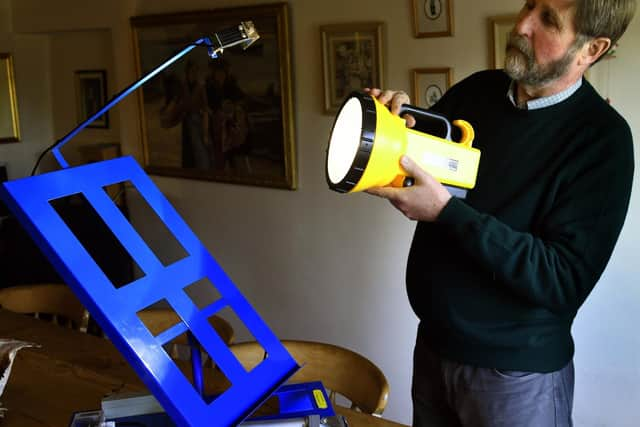Beekeeper Chris invents a new way to produce prize winning beeswax
Chris Smailes has been a beekeeper since he was eight years old, following in his father’s footsteps when the family lived in Gilling East.
Sixty years on and Chris, who produces Westfields Honey from his home in Fadmoor on the North York Moors, is no longer just a beekeeper, apiarist or apiculturist, as he and his fellow honey farmers are sometimes called, he is also an inventor having created The Solar Tracker, a device which harnesses solar power to extract and purify beeswax.
Advertisement
Hide AdAdvertisement
Hide AdAs well as prize winning honey – Westfields Honey took the Supreme Champion title at last year’s Great Yorkshire Show – the couple (wife Linda) also show their beeswax


The couple who have never lived more than 200 yards apart and created a Longhorn cattle dynastyEwe give birth to triplets - in pictures
“Beeswax is a very much overlooked byproduct,” Chris said.
“Ours is used for making polish, candles and recently moustache wax. We’ve had the odd request for church candles made out of pure beeswax.”
He also said beeswax was proving very popular as a green alternative to some plastics.
Advertisement
Hide AdAdvertisement
Hide Ad“Wax wraps for food are currently very much in vogue as an eco-friendly alternative to clingfilm. All part of the drive to get away from single use plastic.”
Chris said he had the idea for The Solar Tracker in the back of his mind for several years before trying to come up with a working model.
“Using solar power to extract and purify wax is nothing new,” he explained.
“I built my first simple box with a glass front on it when I was 11. The process involves putting a bag of raw wax into the heat of the sun and the purified wax trickles through the bag, leaving the muck and rubbish behind.
Advertisement
Hide AdAdvertisement
Hide Ad“The problem had always been that unless you were on hand to continually shift the box into the sun as its rays moved, the process would take quite a long time.
“So we invented The Solar Tracker with our sons handling the design. Our prototype worked better than we had ever thought and doubled our wax produced.
“We’ve since moved on to Mk III, which is essentially a motorised cradle that locates the sun’s position and automatically follows its orbit. That’s why we can produce more wax than ever before, because we are maintaining the heating and thereby increasing melting efficiency.”
The invention has won a number of awards but Chris is keen to stress they have not set up their Solar Tracker to earn themselves vast amounts of money. He wants all of his fellow beekeepers to be able to benefit from his creation.
Advertisement
Hide AdAdvertisement
Hide Ad“This was my ideal opportunity to put something back into a hobby that has given me so much enjoyment and fulfilment throughout my life.
“We are not some big company, we only have around 30 hives and I wanted to produce something that was both affordable and used local manufacturers. I am pleased to say we have managed both of those objectives.”
Chris said The Solar Tracker is taking up a great deal of the couple’s time at present.
“I’m delighted to have been asked to speak at conferences and to groups, including the delegates meeting of the Yorkshire Beekeepers Association at the Pavilions of Harrogate,” he said.
Advertisement
Hide AdAdvertisement
Hide AdBut while the beeswax is currently centre stage, the business’s main product is honey.
“Heather honey has proved our forte,” Chris said.
“It’s how we’ve made our name and we are able to provide it because of where we are and we move our hives up into the heather in the moors in Bransdale. We’ve won many prizes for it, both in national and regional competitions including last year’s Supreme Champion at the Great Yorkshire Show.”
Westfield Honey is very much a joint effort with Chris concentrating on the business of beekeeping and honey and Linda focused on the sales and marketing side as well as dealing with the by-products which includes the wax, lip balms, honey fudge and sauces.
With bees forming the integral part of his business, Chris did express concerns about the Asian Hornet which is a troubling honeybee predator.
Advertisement
Hide AdAdvertisement
Hide Ad“It has been a relatively new threat over the last three to four years,” he said.
“Similar to the European hornet, they build huge nests in the tops of the tallest trees, the size of two footballs. They hover, hawking, over bees about to take off or just coming back to the hive, seize them, chew their heads off and eat their abdomen.
“They can totally destroy a whole colony of typically 50,000 to 60,000 bees in a few days.
“There have been isolated finds in the south of England so far and Defra has a huge system in place to destroy them and hopefully they will be eradicated.”
Comment Guidelines
National World encourages reader discussion on our stories. User feedback, insights and back-and-forth exchanges add a rich layer of context to reporting. Please review our Community Guidelines before commenting.